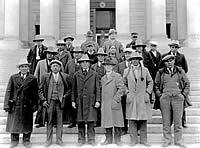
"Caddo Indian Tribe Business
Committee and Friends on the steps of the Oklahoma State
Capitol Building, January 25th, 1929." Archives
and Manuscripts Division, Oklahoma Historical Society.
|
Frequently Asked
Questions Regarding Indian Law
Who is considered to be an Indian?
Indian tribes have the authority and power to
define their own requirements for membership. Tribal
membership is most frequently defined by blood quantum,
however...
read
more>>
|
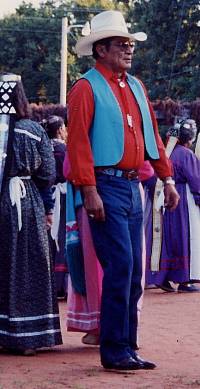
Leonard "Tony" Williams,
Chairman 1992. Williams was an enthusiastic Turkey Dance
partner. He was reared in a traditional Caddo family
and honored the ways of his people for all his life.
He was one of the founding members of the Caddo Culture
Club, organized in 1990 to involve youths in cultural
activities and ensure that traditional songs and dances
continue to pass from generation to generation. Photo
by Cecile Carter.
|
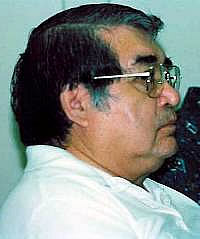
Vernon Hunter, Chairman 1997. Photo
by Cecile Carter.
|
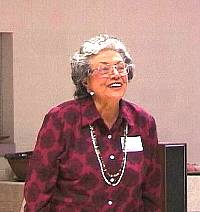
Mary Louise Downing Davis, Vice-Chairwoman
2000. Photo by Cecile Carter.
|
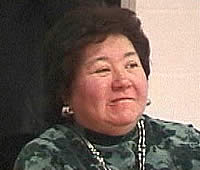
Joyce Hendrix Hinse, Council Secretary
2000. Photo by Cecile Carter.
|
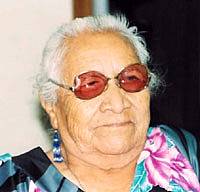
In 1993, Clara Brown remembered taking
lunch to her husband when he was one of the group of
men who built the Caddo Community House. She said that
in the 1930s men used to sit under trees at Fritz Hendrix's
place and sing songs everyday. Photo by Cecile Carter.
|
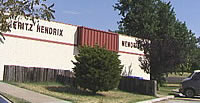
The Fritz Hendrix Memorial building
is the Caddo Senior Citizens Center. Photo by Cecile
Carter.
|
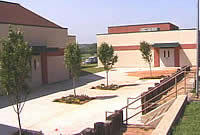
Culture Center and Museum, Caddo
Nation Complex. Photo by Cecile Carter.
|
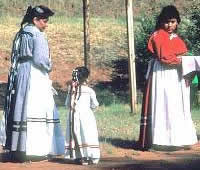
Women circle the arena in the first
phase of the Turkey Dance. Photo by Dayna Lee.
|
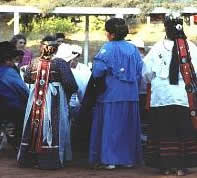
During the third phase of the Turkey
Dance the women gather around the drumming men and sing.
Photo by Dayna Lee.
|
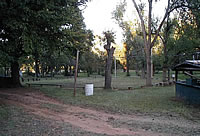
Murrow Dance Grounds in the off season.
The annual Murrow Dance is hosted by descendants of
Chief Whitebread and his wife through their daughter
Ellen, and her husband, Ralph Murrow. Photo by Steve
Black.
|
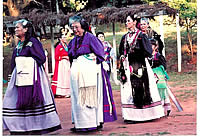
Caddo Dances always begin with the
Women's Turkey Dance, Nu ka oshun. Photo by Cecile Carter.
|
|
The Flag Song is sung while the American flag raised
on a pole beside the dance ground is lowered. Photo
by Cecile Carter.
|
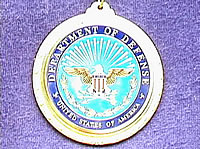
Specially designed medals were presented
to Caddo veterans honored in 2003 by a dance hosted
by Pete Whitebead, recipient of a Purple Heart for his
service in the Viet Nam War. Photo by Cecile Carter.
|
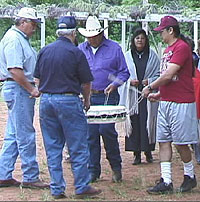
Singer and drummers lead the Drum
Dance, first of the evening dances. Those who know them
join in singing the Drum Dance songs bonding them with
the Old People, Ancestors, Kee-o-nah wah'-wah ha-e-may'-chee.
May 2, 2003. Photo by Cecile Carter.
|
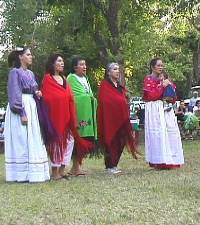
Everyone follows the lead singers and drummers.
Photo by Cecile Carter. |
|
Whatever the U.S. government's motives were
for breaking tribally held land into individually held allotments—land
greedy interests (as seems transparent) or humanitarian ideals
(as claimed)—the action was an affront to the inherent
right of Caddo people to live and be governed as they wished.
Tending small gardens for the family and coming together to
plant large fields for the benefit of all was their age-old
way of life. Ancient ceremonies and celebrations gave expression
to their deep-seated spiritual beliefs. Forced moves from
homelands and a harsh environment in Indian Territory interrupted
Caddo self-sufficiency, but the constancy of their traditional
leadership was never doubted by Caddo people.
In the twentieth century, though, they were
painfully aware that the United States did not recognize the
Caddo form of government as legitimate. The President, Congress,
Secretary of Interior and lesser Washington officials were
deaf to the voices of Caddo leaders. The time had come for
the old Caddo way of governance to be "thrown away"
and a new way brought about.
Two Congressional Acts, the Indian Reorganization
Act (1934) and the follow up Oklahoma Indian Welfare Act (1936)
reversed U.S. policy favoring Indian assimilation. The first
recognized the right of self-determination for Native Americans,
authorized limited self-government under constitutions approved
by the Secretary of the Interior, and allowed the formation
of corporations to manage resources. Oklahoma was exempted
from the Indian Reorganization Act but the Oklahoma Indian
Welfare Act amended the Indian Reorganization Act to provide
for the organization on Indian tribes State of Oklahoma.
These federal laws cleared the path that led
the Caddo to organize a new form of government and receive
recognition as a sovereign nation with inherent right to self-government.
On the 17th day of the new year of 1938, surviving adult members
of the old Caddo Nation's three branches—Caddo, Hasinai,Natchitoches—voted
to accept Constitution and By-laws of the Caddo Indian Tribe
of Oklahoma. The vote was 314 for, 38 against. Ten months
later the Secretary of the Interior issued a Charter of incorporation
to the Caddo Tribe of Oklahoma. The Charter spelled out the
limits of tribal functions within the federal system as well
as safeguarding Caddo power: "To promote in any way the
general welfare. To advance the standard of living of the
Tribe through development of tribal resources, the acquisition
of new tribal land, the preservation of existing land holdings,
the better utilization of land and the development of a credit
program for the Tribe."
It was not easy for Caddos to become accustomed
to electing leaders. And it was not easy for those elected
to blend the role of Caddi with that of Chairman, nit-tso-sah-dos-cha-ah,
"one who takes the chair." The uppermost concern
of a Caddi often centered on cultural tradition. More and
more the responsibilities of Chairman became much like those
of a CEO for any corporate business. By mid-1990, tribal affairs
entailed complicated legal and business matters that required
expertise two hundred years advanced from the knowledge and
experience that made caddis powerful in earlier times. The
original Constitution and By-laws was amended and, in 1976,
revised and rewritten to better serve the best interest of
the Caddo Indian Tribe.
LaRue Martin Parker elected Chairman in 1999
and re-elected in 2001, is not the first woman to take responsibility
for directing the welfare of the Caddo Nation. She is, however,
the first to preside over an all female Council who have been
known to call themselves as the "Caddo grandmothers."
The next major constitutional change came with the adoption
of four amendments in 2002. The organizational name, Caddo
Indian Tribe of Oklahoma was officially changed to The Caddo
Nation of Oklahoma; blood quanta eligibility for membership
was reduced from at least one-eighth to at least one-sixteenth;
the period for terms in office for council members was increased
from two to four years.
The old Community House, built on five acres
deeded to the Caddo Indian Tribe of Oklahoma by Fritz Hendrix
and his wife Eva Longhorn Hendrix in 1940, was the center
of activities for many years. Hendrix was a son of Caddo Jake
and a leader of importance during the transition between traditional
leadership and constitutional government. Identified as Chairman
of the Business Committee, he signed the certificate of Corporate
Charter in 1938. The land from his allotment was deeded "in
consideration of the construction and maintenance of community
project.
Shaded by large, old, oak trees, next to the
Dance Ground, the Community House is still a center for Caddo
family gatherings and tribal functions. Downhill, the present
Caddo Tribal Complex has grown steadily since the first modern
building was dedicated to the memory of Fritz Hendrix. The
building first housed tribal offices and is now the Senior
Citizens Center. Next door is the Culture Center containing
Historic Preservation offices, a large indoor dance arena.
The Tribal Heritage Museum was more recently built next door.
A much larger building now houses administration offices.
The old dance ground on the hill above modern
buildings within the Tribal Complex is vibrant with color
and sound during warm months of the year. There is no set
calendar for these Caddo Dances—they are announced in
the old way. Someone will say, I'm going to give a dance on
such-and-such day, and the people come. Beginning in late
spring, fresh willow branches are cut and laid on top the
arbor frame that outlines the dance circle. The ground inside
the circle is swept clean. Grass surrounding the circle outside
the arbor is cut and cleared of winter debris. The old Murrow
Dance Ground is meticulously groomed for the annual dance
hosted by descendants of Chief Whitebread, his wife, their
daughter Ellen and her husband Ralph Murrow. Many families
camp under arbors, in tents, trailers, or RVs for two or three
nights of dancing.
Dancing always begins with the women's Turkey
Dance, Nu ka oshun. It starts in the afternoon, whenever tree
shadows begin to shade the circle. The drum is set in the
middle of the dance circle and the singers beat the rhythm
of the first song, "Come on Turkeys!" Women and
girls hearing the call enter the dance circle from all directions.
Caddo girls are taught from an early age, "You're Caddo,
you are one of us, you need to Turkey Dance." Turkey
Dance is a celebration—celebration of the survival of
the Caddo Nation.
When all are gathered, dancing with steps balanced
on the ball of their feet, a song urges, "Kick, Kick
the dirt!" The songs relate Caddo history—telling
about enemy encounters, victories won, and major events such
as the overnight formation of Caddo Lake. The songs are so
old that no one knows when they were first danced.
There are various stories about the origin of the Turkey Dance.
The most commonly told is that a hunter was in the woods when
he heard beautiful songs. Following the sounds he discovered
a group of turkey hens dancing around a gobbler. He watched
long enough to fix the dance in his memory and returned home
to tell all about it. After that, the dance he described was
used with songs composed to record the people's history.
Spanish missionaries in the 1700s described
Hasinai women performing a dance to celebrate the return of
warriors. Today, women and girls select a male partner to
welcome into the circle for the final stage of Turkey Dance.
The entire cycle of songs is seldom sung. Some songs have
been discarded over the years. Others have been and may still
be added. Even a shortened version lasts an hour or more,
and it must be finished before sundown. Remember, that's when
turkeys go to roost for the night.
The American flag raised on a pole beside the
dance ground is lowered at the end of Turkey Dance. The Flag
Song accompanies the ceremony. Composed at the beginning of
World War II, the words are:
Wunti shiahtsi ka kin ha nah
All the boys that means them
Kwi ahii sah dawi yasah
Where he was over there
Ki ah huu nit nah da gah
He came back now is among them.
Pete Whitebead, who served two tours in Viet
Nam and was awarded a Purple Heart medal, gave a dance to
honor Caddo veterans in June of 2003. After the Flag was lowered
that day, he carried it back to its owner, the widow of another
Viet Nam soldier. On Whitebead's request, the Department of
Defense sent special medals made for presentation to honored
veterans later in the evening.
Dinner for everyone is served following Turkey
Dance and the lowering of the Flag. Plates are served in the
Community House and carried to seats under the arbor. The
first dance of the evening is the Drum Dance. For Drum Dance,
the drum carried clockwise around the circle in harmony with
earth's rotation. The leaders are men, singers and drummers.
Young boys are encouraged to learn the songs by joining the
lead singers, but they are not allowed to beat the drum. Everyone
else falls in behind.
Songs are sung starting from the west side and
between brief stops at the points, north, east, and south.
The songs relate to the beginning of Caddo people on earth;
coming up from the old world of darkness into the new world
of light where they now live. For the last segment, the drum
is carried to the middle of the dance ground and the drummers
rotate in the center while the dancers move around them in
the direction of the earth.
Turkey Dance and Drum Dance are the heart of
Caddo culture. Both have significance in the preservation
or language, thought, and the spirit of Caddos past and present.
The dances that follow, Duck Dance, Bear Dance, Swing Dance,
Stirrup Dance and a string of others are light hearted fun.
The songs of one of the last dances, the Bell Dance, are the
most beautiful and may be the oldest. There is no drum, only
the ring of bells in the hand of the leader. Tony Williams
was reared in a traditional Caddo family and honored the ways
of his people for all his life. He was one of the founding
members of the Caddo Culture Club, organized in 1990 to involve
youths in cultural activities and ensure that traditional
song and dance continues to pass from generation to generation.
|
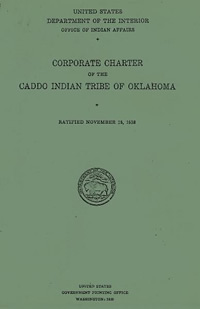
In 1938 the Secretary of the Interior
issued a Charter of incorporation to the Caddo Tribe
of Oklahoma. The Charter spelled out the limits of tribal
functions within the federal system as well as safeguarding
Caddo power: "To promote in any way the general
welfare. To advance the standard of living of the Tribe
through development of tribal resources, the acquisition
of new tribal land, the preservation of existing land
holdings, the better utilization of land and the development
of a credit program for the Tribe."
|
Frequently asked
Questions Regarding the Caddo Indian Nation
Who is a Caddo?
A Caddo person is defined by the Constitution and
By-laws of the Caddo Nation...
read
more>>
|
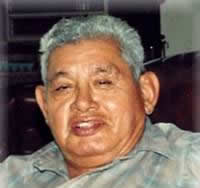
Noah Frank, Chairman 1995. Photo
by Cecile Carter.
|
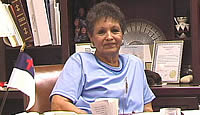
LaRue Martin Parker, Caddo Tribal
Chairman 1999-. Photo by Cecile Carter.
|
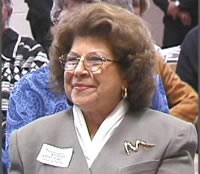
Frances Cussen Kodaseet, Council
Representative 2000. Photo by Cecile Carter.
|

Working Council, August, 2003. Photo
by Cecile Carter.
|
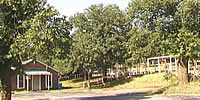
The old Community House has been
a center for Caddo activities since sometime around
1938. Photo by Cecile Carter.
|
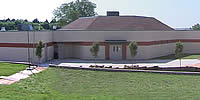
Culture Center, Caddo Nation Complex.
Photo by Cecile Carter.
|

Administration Building, Caddo Nation
Complex. Photo by Cecile Carter.
|

Dance ground at the Caddo Nation
Complex. Photo by Cecile Carter.
|
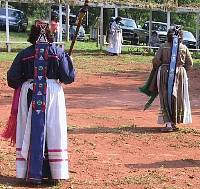
Women wearing traditional dance costumes
enter the dance arena at the start of the Turkey Dance.
The woman on the left, Frances Cussen Kodaseet, carries
a leadership cane believed to have been presented to
the Caddo by the Spanish prior to 1809. Photo by Dayna
Lee.
|
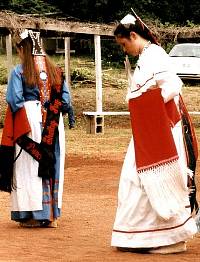
Second phase of the Turkey Dance.
Photo by Dayna Lee.
|
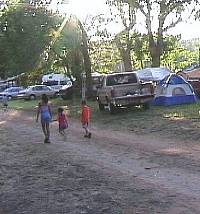
Caddos enjoy congeniality in camping
during dances held on the dance ground at the Tribal
Complex and the annual dance held at the oldest dance
ground still in use, the Murrow Dance Ground. Photo
by Cecile Carter.
|
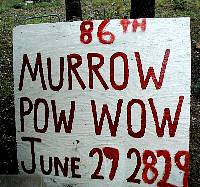
The 86th Annual Murrow Dance was
held June 27-29, 2002. Photo by Steve Black.
|
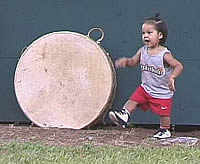
Youngster playing near drum at Murrow
Dance Ground. Photo by Cecile Carter.
|

Pete Whitebead returns the folded American flag to the
widow of a Caddo warrior who permitted her husband's flag
to be raised for a dance honoring veterans in 2003. Photo
by Cecile Carter. |
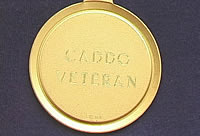
Back of special Caddo veterans medal.
Photo by Cecile Carter.
|
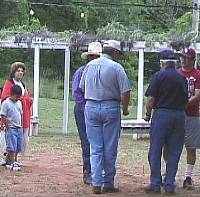
Young boys are encouraged to learn
Drum Dance songs by joining the lead singers, but they
are not allowed to beat the drum. May 2, 2003. Photo
by Cecile Carter.
|
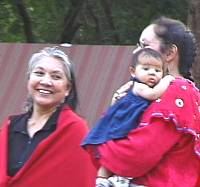
Even the youngest feels the beat of the drum. Photo by
Cecile Carter. |
|